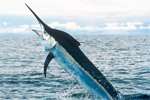A 593 pound Pacific bluefin tuna sold for $735,000 (56.49 million yen) in Tokyo’s Tsukiji market today. This beats the previous record price hit last year by over $260,000. Why so expensive? Bluefin tuna, considered the best sashimi and sushi in the world, have been fished to near extinction with the population of the Pacific bluefin the most stable to date.
The massive fish, one of the largest in the Pacific, was purchased by Kiyoshi Kimura, operator of the 46-store Sushi-Zanmai restaurant chain. Kimura stated he shelled out so much for the fish because he wanted to give Japan some good news after a devastating tsunami and nuclear meltdown last year.
“Japan has been through a lot the last year due to the disaster,” he said. “It needs to stay strong. That’s what I tried to do and I ended up buying the most expensive one.” Kimura also said he wanted the bluefin sushi to stay in Japan.
 A bluefin tuna being used for research. Photo courtesy of NOAA. |
Although listed by the IUCN Red List as Least Concern, overfishing has become a problem for the Pacific bluefin. Last year researchers estimated that the current spawning biomass of Pacific bluefin was only 40-60 percent of its historic spawning biomass. The other two species of bluefin tuna, the Atlantic and southern, are currently listed as Critically Endangered. Given their scarcity, environmentalists and scientists have been pushing for tighter regulations and lower catches (in some cases a complete moratorium on catches) for bluefin tuna.
The Monterey Bay Aquarium Seafood Watch lists warns consumers to avoid all bluefin tuna due to its scarcity and the methods used to catch the fish resulting in high levels of bycatch. There have also been health concerns raised about mercury and PCB levels in bluefin runa.
Japan is by far the largest consumer of tuna. Around 80 percent of global tuna catches are exported to the island nation, mostly for use as sashimi and sushi.
“You know, good things like this are appreciated in the whole world,” said Hirotaka Higurashi, a 22-year-old male customer at Sushi-Zanmai, when asked about overfishing by the AFP. “There is nothing we can do about it.”
Unlike most other fish, tuna are warm-blooded allowing them to inhabit both cold and warm waters. They are top predators in the ocean, impacting the food chain all the way down.
Related articles
First global assessment finds highest-grossing tunas and billfishes most vulnerable to extinction

(11/09/2011) Sleek, powerful tunas and billfishes that ply the open ocean garner some of the highest prices of any fish. In January, a single bluefin tuna fetched a record $396,000 at a Tokyo auction. Yet wild fish populations pay a still higher price for such exorbitant demand: the threat of extinction. The first assessment of an entire group of commercially valuable marine species found that the most threatened fish are generally the ones reeling in the most money, including bluefin tuna and bigeye tuna.
Fishing industry exceeds Atlantic bluefin quota by 141 percent
(10/18/2011) In 2010 the fishing industry exceeded its quota of eastern Atlantic bluefin tuna (Thunnus thynnus) by 141 percent, according to a new analysis by Pew Environment Group. The analysis depends on official data, thereby leaving out the massive black market on Atlantic bluefin tuna.
Ocean prognosis: mass extinction

(06/20/2011) Multiple and converging human impacts on the world’s oceans are putting marine species at risk of a mass extinction not seen for millions of years, according to a panel of oceanic experts. The bleak assessment finds that the world’s oceans are in a significantly worse state than has been widely recognized, although past reports of this nature have hardly been uplifting. The panel, organized by the International Program on the State of the Ocean (IPSO), found that overfishing, pollution, and climate change are synergistically pummeling oceanic ecosystems in ways not seen during human history. Still, the scientists believe that there is time to turn things around if society recognizes the need to change.